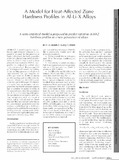| dc.description.abstract | A model based on reaction
kinetics and elemental diffusion is proposed
to account for the presence of
double inflection in the hardness profiles
of the heat-affected zone (HAZ) in weldments
of AI-Li-X alloys tested without
postweld heat treatment (PWHT). Such
profiles are particularly evident when
1 ) the base metal is in the peak-aged (T8
or T6) temper condition prior to welding;
2) the welding process is a high-heat
input process, i.e., gas tungsten arc
(GTA), gas metal arc (GMA) or plasma
arc (PA) welding; and 3) a filler alloy deficient
in lithium (i.e., AA 2319)is used.
In the first part of this paper, the theoretical
mechanisms are presented. It is proposed
that the double inflection appears
due to complete or partial reversion of
the semi-coherent, plate-like precipitates
(i.e., 0% T 1 or S'); coarsening of the platelike
precipitates at constant volume fraction;
precipitation of ~5' as a result of
natural aging; and diffusion of lithium
from the HAZ into the weld pool due to
the concentration gradient between the
weld pool and the base metal. In the second
part (to be published in next month's
Welding Journal), experimental validation
of the model is provided using weldments
of the AI-Li-Cu Alloy 2095. | en |


